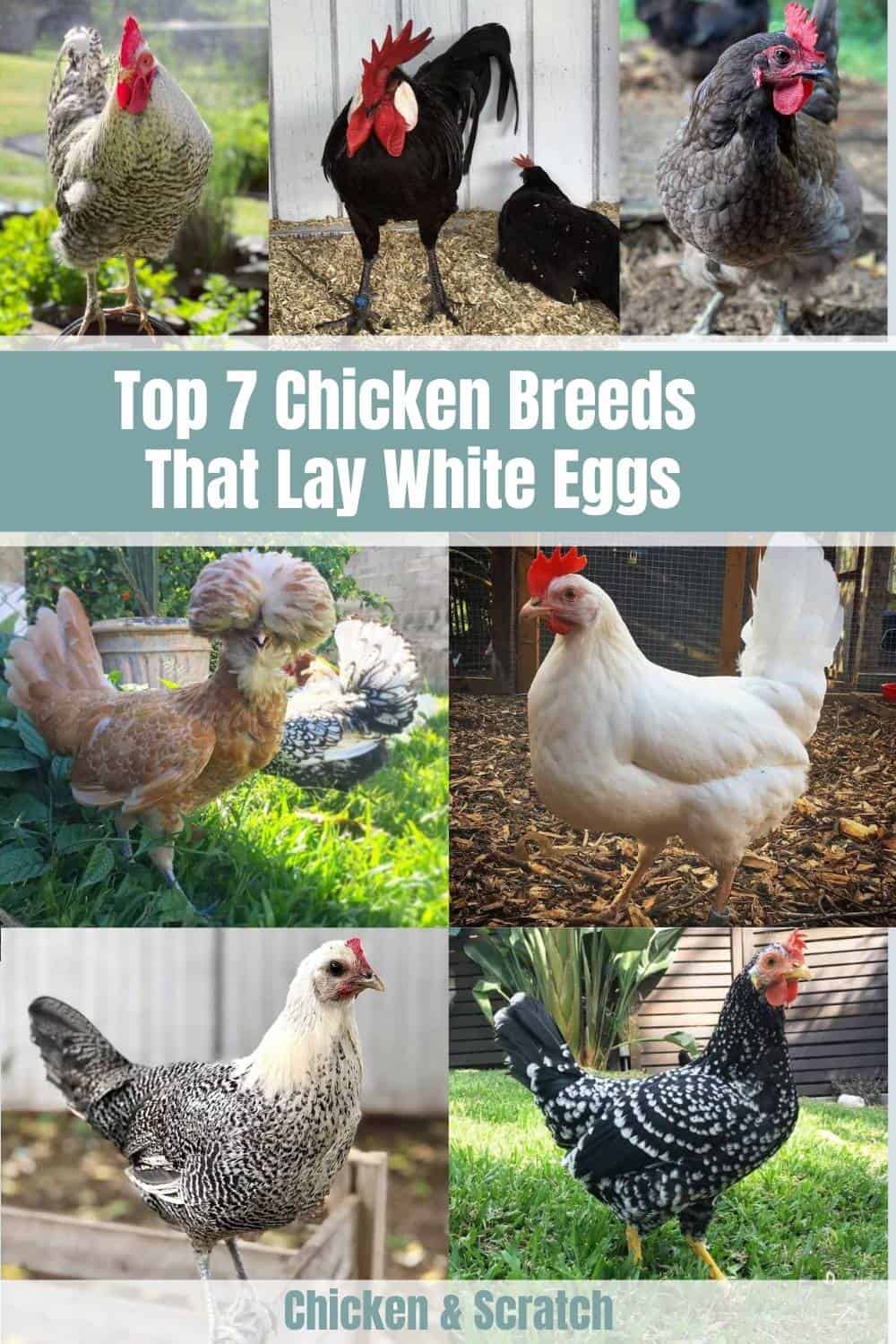One of the most nutritious foods is eggs. Eggs contain vitamins and minerals that increase the good cholesterol in the blood, reduce risks of certain heart diseases and ensure you have enough protein. They also help to ward off excess fat. Below are the top seven chicken breeds that lay healthy, white eggs.
1. Polish Chickens

| Feature | Details |
| Purpose | Ornamental |
| Egg Color | White |
| Egg Size | Small to Medium |
| Broodiness | Not Broody |
| Heat Tolerance | Yes |
| Cold Tolerance | Yes |
| Comb Type | V-shaped Comb |
| Egg Production | About 100 to 200 eggs per year |
| Chicken Skin Color | Yellow |
| Life Span | 8-9 years |
| Adult Weight | Hen: 3-4 lbs, Rooster: 4-6 lbs |
| Backyard Friendly | 4/5 |
Appearance
Polish chickens are one of the few breeds that command attention because of their loveliness. You can’t miss their head feathers. They have been around since the 15th century but were first spotted in the Netherlands; they can live for 8 years and above and make good backyard chickens.
They come in different colors, all of which fall under the breed recognized by the American Poultry Association, and are primarily medium-sized. You’ll find both non-bearded and bearded varieties. The standard colors are white, silver, golden, blue, and black. But there’s a new variety called the Tolburnt, a white and brown mix. Polish chickens are usually white-skinned, which explains why they lay white eggs.
They aren’t difficult to spot. Once you see feathers cascading the heads of some chickens, they are undoubtedly Polish chickens. Sometimes, the feathers are too much that they’re unable to see correctly. Both sexes have head feathers, gray legs, red wattles, and white earlobes. Each foot has 4 toes and isn’t feathered. The rooster weighs about 6 pounds, while the hens weigh around 3 to 4 pounds.
Personality
You shouldn’t raise them in a cramped space as they’re likely to pick one another’s head feathers and hurt themselves in the process. Their friendly and calm temperament makes them suitable to be around kids.
However, they are easily frightened. Their docile nature also makes them prey to other aggressive chicken breeds. As such, only mix them with other docile chicken breeds. When approaching their coop, do so gently so that you don’t frighten them unnecessarily. Besides, they are reticent even when chattering. You can rest assured they won’t disturb the neighbors if you breed them.
Egg production
Their eggs are white, which is characteristic of the Polish chicken breed. The hens lay about 4 eggs per week, which translates to 200 per year. Their eggs are relatively big too. They start laying eggs around 5 months old. However, most breeders raise them for exhibition instead of egg production nowadays.
Care
Polish chickens are low-maintenance birds. They aren’t fragile, but you have to regularly take care of their head feathers to keep parasites off. Also, ensure their diet is fortified with adequate protein, and there’s a personal space of at least 4 Square feet for each chicken in their coop. Learn more about Polish Chickens.
2. The Black Minorca
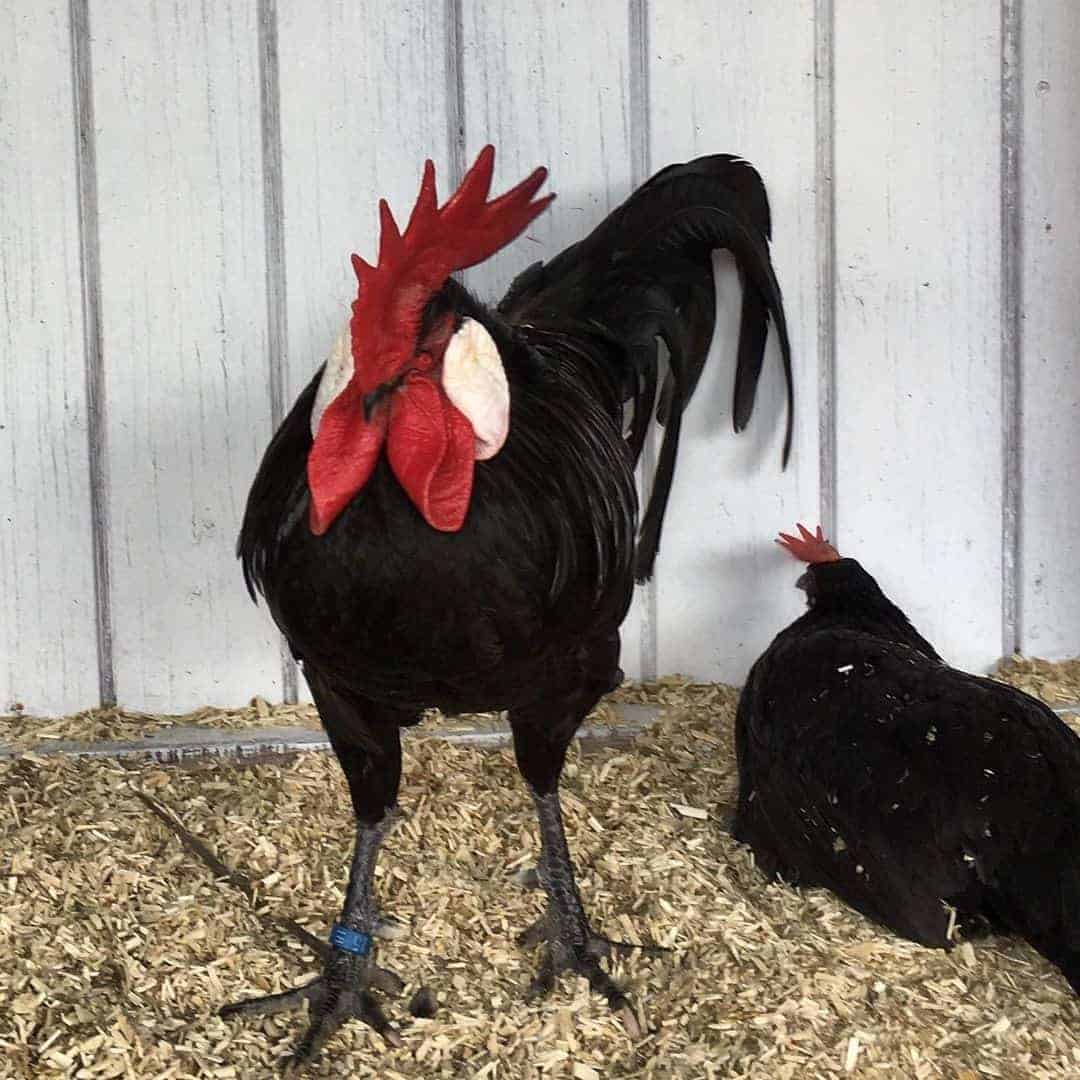
| Feature | Details |
| Purpose | Egg-laying |
| Egg Color | White |
| Egg Size | Large to Very Large |
| Broodiness | Not Broody |
| Heat Tolerance | Yes |
| Cold Tolerance | No |
| Comb Type | Single Comb |
| Egg Production | About 120 to 220 eggs per year |
| Chicken Skin Color | White |
| Life Span | 6-10 years |
| Adult Weight | Hen: 7.5 lbs, Rooster: 9 lbs |
| Backyard Friendly | 5/5 |
Appearance
Being the largest of the Minorcas, the Black Minorca has a very striking appearance. Minorcas are often considered Mediterranean breeds as they are from Spain. With huge earlobes, wattles, and combs, the Black Minorca carries itself elegantly.
The feathers are luminescent and give a glimmery, green color in the sun. However, because of their huge flesh, Minorcas are more vulnerable to frostbite during winter. Their tails are long and tilted upwards, while their skin color is a mix of white and pink. They come in medium and large sizes but have slender bodies. Their legs are long and slate-colored.
Personality
Since this breed loves relating to humans, it is flighty. Therefore, you have to be careful around it. Minorcas also love to forage, so you can’t keep them cooped up in a place. They love hot weather and are perfect for homesteading. Generally, they have good temperaments.
Egg production
Asides from their elegant appearance, the Black Minorca is prolific at laying big, white eggs. The chances are high that you’ll get double-yolked eggs if you rear this breed. Even though it doesn’t lay as many eggs as other breeds, the Black Minorca’s eggs are classic white and healthy.
However, it doesn’t do well in winter as it isn’t a cold-hardy breed. As such, you might not get as many eggs as you want. In addition, if you’re looking at the eggs hatching into chicks, you shouldn’t count on the Minorca hen. By nature, it doesn’t brood.
Care
This chicken breed doesn’t have any health issues. However, they need special care and attention during winter as they are vulnerable to frostbite. Besides, ensure their feed is of high quality so that you can easily maintain their weight and egg production abilities. Minorcas aren’t dirty, but it’s advisable you keep their cage clean and disinfected. Learn more about Minorca Chicken.
3. White Leghorns
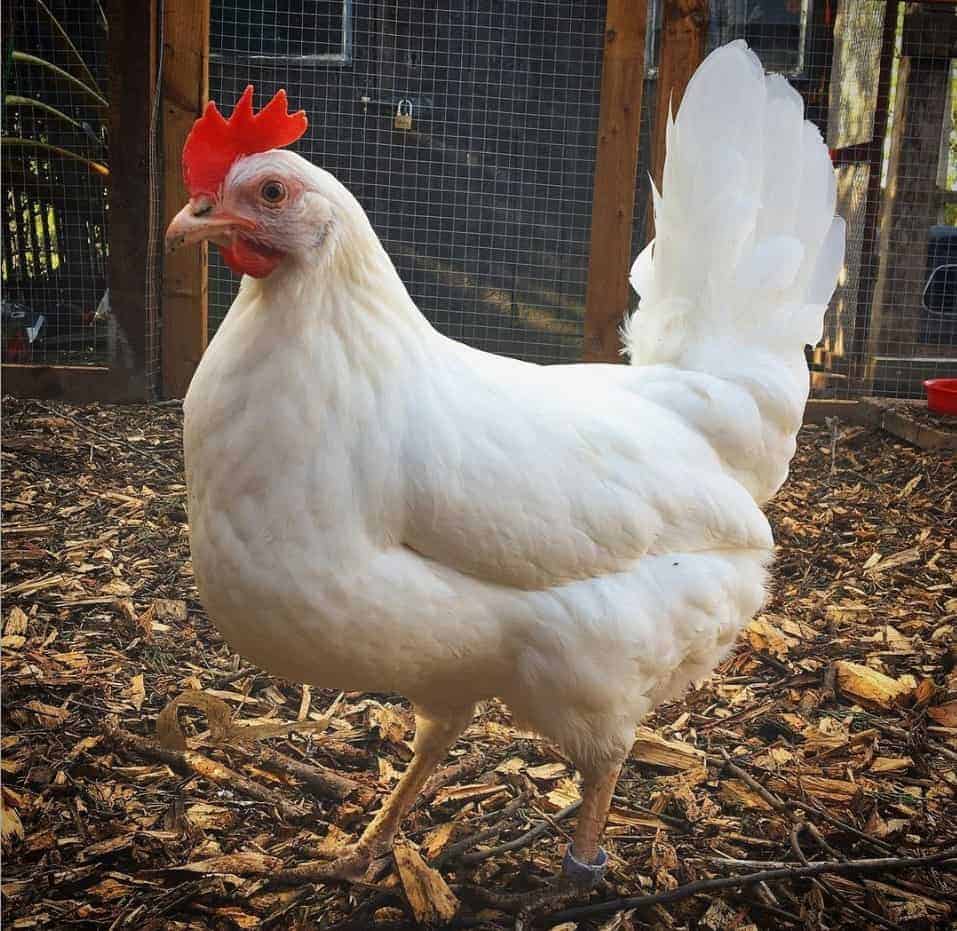
| Feature | Details |
| Purpose | Egg-laying |
| Egg Color | White |
| Egg Size | Large |
| Broodiness | Not Broody |
| Heat Tolerance | Yes |
| Cold Tolerance | No |
| Comb Type | Single Comb |
| Egg Production | About 280 to 320 eggs per year |
| Chicken Skin Color | Yellow |
| Life Span | 4-6 years |
| Adult Weight | Hen: 5-6 lbs, Rooster: 7-8.5 lbs |
| Backyard Friendly | 5/5 |
Appearance
Recognized by the American Poultry Association in 1874, Leghorn Chickens come in almost 12 varieties, but the White Leghorn is the most popular. The varieties include Buff Columbian, Exchequer, Barred, Dark Brown, etc.
White Leghorns, identifiable by their single comb, red wattles, and white earlobes, are easy to spot. The skin, beak, and legs are usually yellow, while the eyes are red. Leghorns are believed to have originated from Tuscany, Italy.
They got their name from the Italian city of Livorno, from which they were first taken to America and other parts of the world. Before this, they were referred to as Italians. Even though white Leghorns are popular, there are different colors.
Their bodies are long, which makes their appearance elegant. They don’t weigh much as well. For instance, the rooster weighs about 7½ pounds, while the hens weigh 5 to 6 pounds. However, depending on the varieties, not all Leghorns weigh the same.
Personality
White Leghorns are diligent and proactive, as shown by their ability to forage for food. You’ll always find them hunting in different places as far as they can go. They mature quickly, so you’ll start collecting their eggs not long after you start raising them.
They’re noisy but timid; they might run away from you when you approach them. But with frequent exposure to you, they’ll become pliable. They can survive in all climates but are vulnerable to frostbite.
Egg production
They are very prolific at egg-laying. They can lay up to over 300 eggs per year. Their eggs are white and get larger towards the end of their egg-laying cycle. However, they’re not predisposed to incubating their eggs. They keep laying eggs into their fourth year.
Care
In addition, Leghorns are hardy birds; they can survive in any season and don’t eat much. However, some parts of their bodies can quickly get frostbitten during winter. So, you should protect them during the cold season. Learn more about Leghorn Chicken.
4. Ancona Chickens
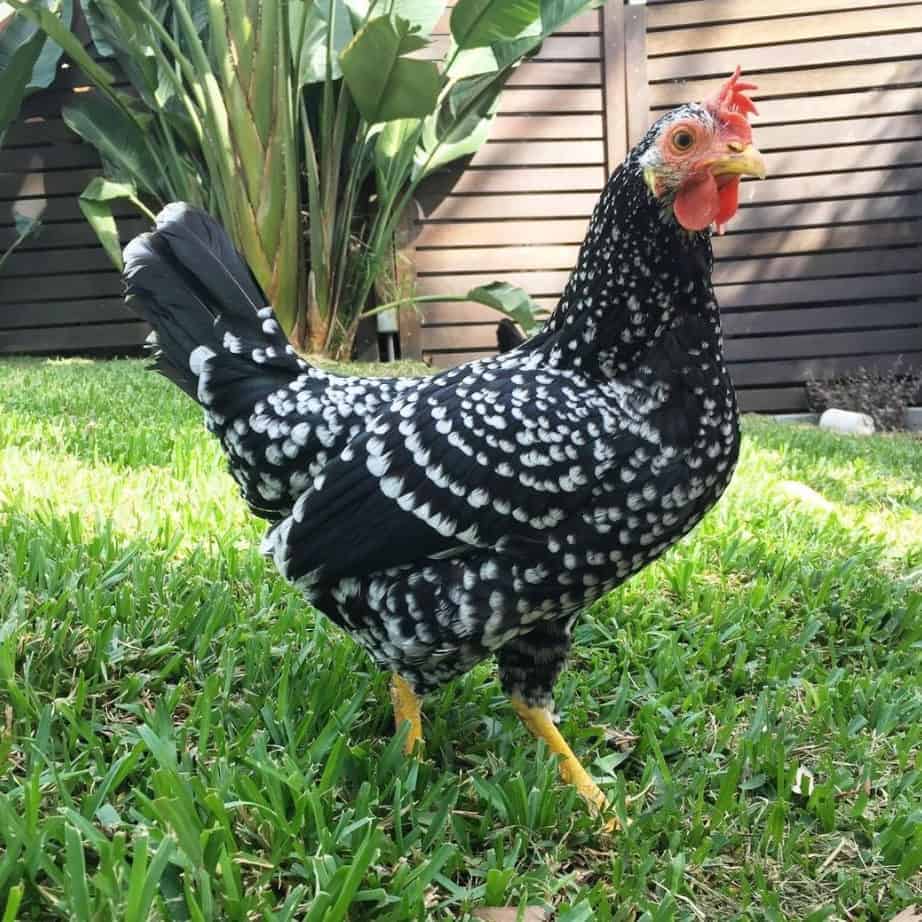
| Feature | Information |
| Purpose | Dual purpose (meat & eggs) |
| Egg Color | White |
| Egg Size | Medium to Large |
| Broody | No |
| Heat Tolerance | Yes |
| Cold Tolerance | Yes |
| Comb Type | Single Comb & Rose Comb |
| Egg Production | 180 to 280 eggs per year |
| Chicken Skin Color | Yellow |
| Life Span | Not mentioned in the text |
| Adult Weight | Hen: 4.5 lbs Rooster: 6 lbs |
| Backyard Friendly | 4/5 |
Appearance
Ancona chickens are also another Mediterranean breed that is well-known for laying white eggs. Their feathers are black with white spots all over. They were discovered in Marche, Italy before being exported to other parts of the world and recognized by the American Poultry Association in 1898.
They were named after the seaport city in Italy, Ancona. Their skins are either white or pale, and their legs are clean with white earlobes and red eyes. Ancona chickens have their bodies well covered with feathers. Also, they come in 2 varieties: rose-combed or single-combed. Due to their eye-catching appearance, some breeders use them as show birds.
Personality
One prominent quality of Ancona chickens is their desire to free-range a lot. They love to peck at grains, grasses, etc., which translates into less money spent on feed for you. They’re also very alert to their surroundings and love to fly.
You’ll see them flying whenever they cite predators in their surroundings. Besides, Anconas are entertaining. You’ll enjoy their company a lot as they are always chatty and will keep themselves busy, even if they aren’t allowed to forage.
Egg production
This chicken breed is very fertile; sometimes, it lays up to 220 eggs per year. Sometimes, they lay eggs through the cold and dry seasons. They are hardy birds, and the weather doesn’t determine when they lay eggs or not. You can rest assured you’ll find eggs to collect almost every time you go to their coop. However, they aren’t broody by nature, so you won’t find them sitting on their eggs.
Care
They are cold-hardy and cope well as long as the conditions are right. For instance, their shelter must be well-cleaned, and healthy food and clean water must be provided always. They are low-maintenance birds as well, so you can raise them on a budget. Learn more about Ancona Chicken.
5. Hollands

| Feature | Details |
| Purpose | Dual-purpose |
| Egg Color | White |
| Egg Size | Medium |
| Broodiness | Not Broody |
| Heat Tolerance | Yes |
| Cold Tolerance | Yes |
| Comb Type | Single Comb |
| Egg Production | About 150 to 180 eggs per year |
| Chicken Skin Color | Yellow |
| Life Span | 6-8 years |
| Adult Weight | Hen: 5.5 lbs, Rooster: 7.5 lbs |
| Backyard Friendly | 4/5 |
Appearance
Hollands is a breed of chickens developed at the Rutgers Breeding Farm in New Jersey in the 1930s. There are 2 varieties: White and Barred. White Hollands were obtained from crossing Lamonas, Rhode Island, New Hampshire, and White Leghorns together, while Barred Hollands were created from crossing Australorps, Brown Leghorns, White Leghorns, and Barred Plymouth Rocks.
Even though Hollands are rare, they are reared for both their meat and eggs. They were admitted into the American Poultry Association in 1949. The roosters weigh about 4 kg, while the hens weigh 3 kg. Their wattles, combs, and earlobes are red, with six sharp points on their combs. White Hollands have white skin, while Barred Hollands have yellow skin.
Personality
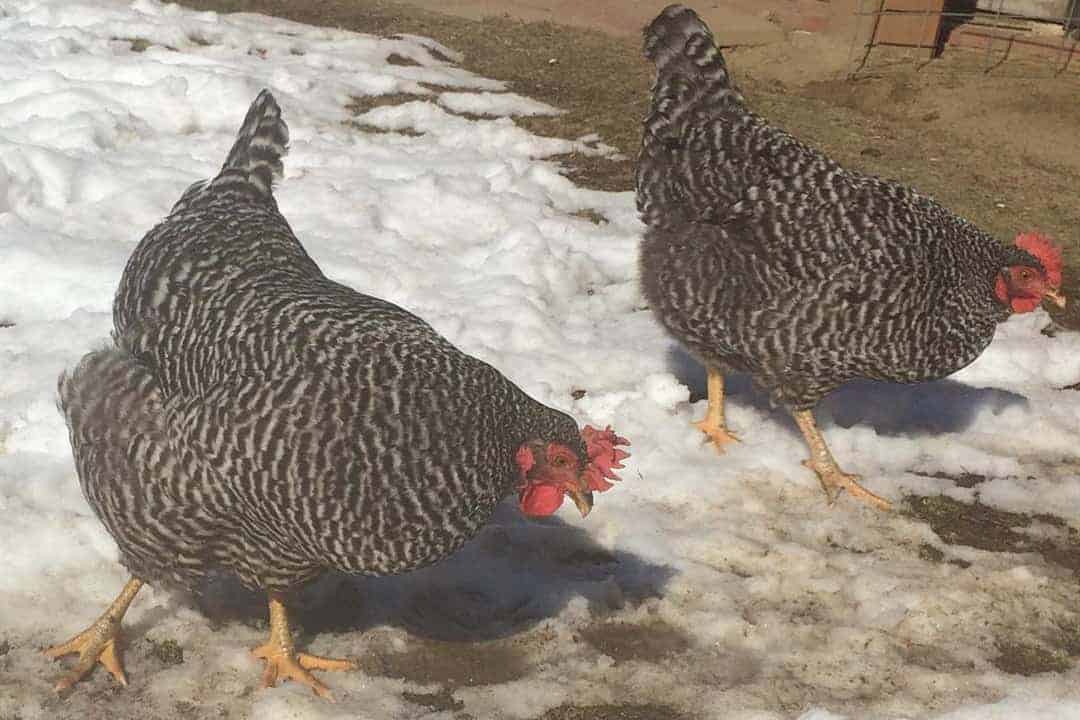
Hollands are naturally docile, calm, and cheerful. As such, they are perfect for backyard chickens. They adapt to any condition they find themselves in and do well with confinement, even though they also like to forage. Despite their generally non-broody nature, when they do sit on their eggs, they make good mothers. However, they grow slowly.
Egg production
Initially, Hollands was created to lay white eggs. You can get 4 eggs from each Holland per week. Their eggs are white and large as long as they’re properly fed.
Care
You need to add calcium to your Hollands’ diet to want their eggs to have strong shells. Also, you should make their coop big enough for each chicken to have some personal space to forage. This will prevent them from stepping and turning on one another.
Ensure the coop is fenced, too, to ward off predators. Hollands have a robust immune system, which keeps them from diseases. However, you should keep an eye on them. Parasites can make life frustrating for your chickens, and you want to deal with them as soon as possible.
While Hollands are generally suitable for both hot and cold environments, care should be taken with those with larger combs as they may be more susceptible to frostbite in cold conditions. Learn more about Holland Chicken.
6. Andalusians
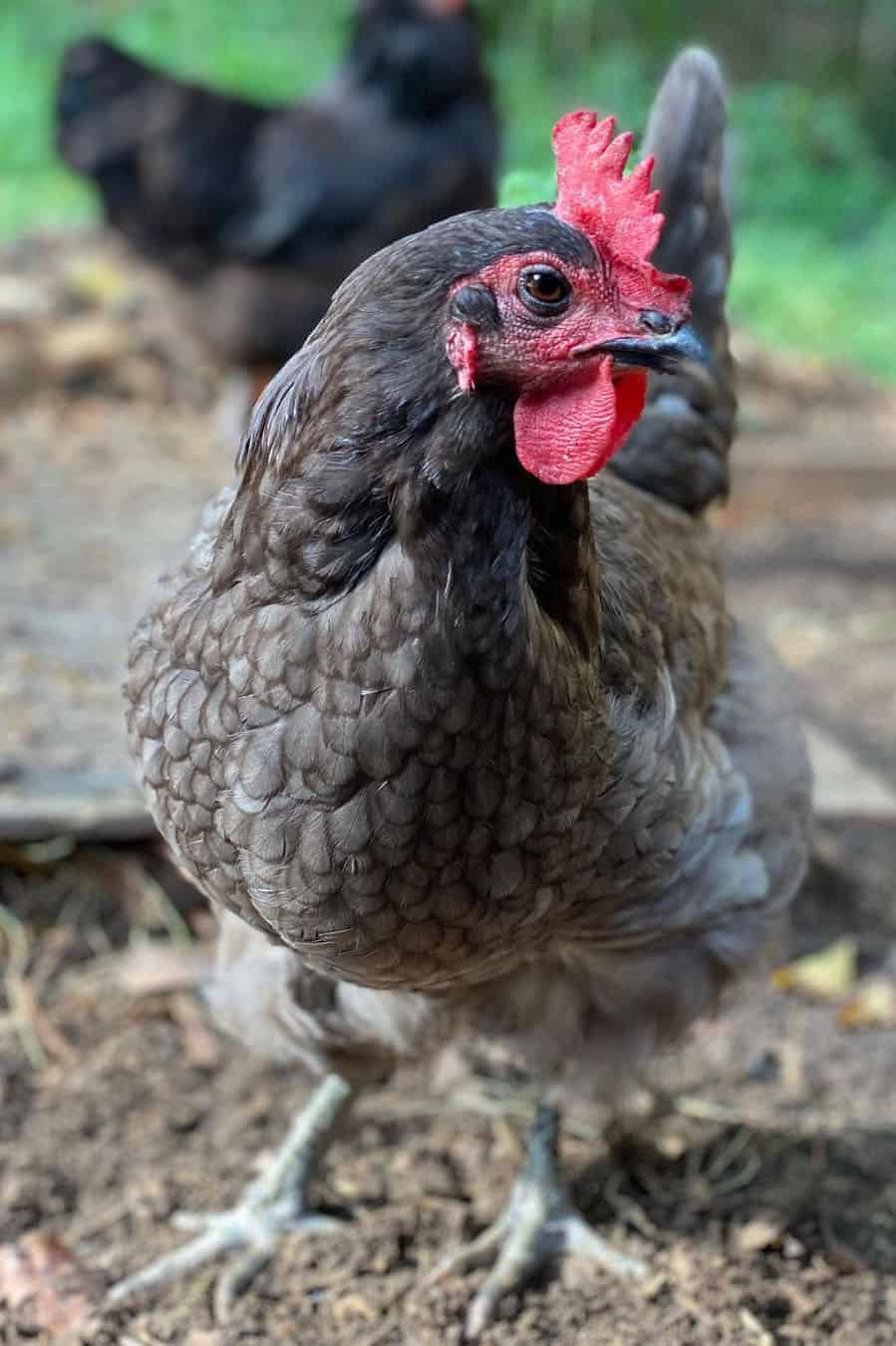
| Feature | Details |
| Purpose | Ornamental |
| Egg Color | White |
| Egg Size | Medium to Large |
| Broodiness | Not Broody |
| Heat Tolerance | Yes |
| Cold Tolerance | Yes |
| Comb Type | Single Comb |
| Egg Production | About 100 to 150 eggs per year |
| Chicken Skin Color | White |
| Life Span | 5-8 years |
| Adult Weight | Hen: 4-5.5 lbs, Rooster: 6-7 lbs |
| Backyard Friendly | 4/5 |
Appearance
This chicken breed was developed in Andalucia, Spain. One of the first things to note about this bird is its beautiful appearance and confidence, even though they are light and small. The earlobes are white, while the wattles and combs are bright red.
The legs are clean, and each foot has 4 toes. The American Poultry Association admitted it in 1874. Even though there are other varieties of the breed, the blue variety is the most recognized.
This variety has blue-colored feathers. Blue Andalusians are created by crossing white with black varieties. However, with time, the color becomes washed out. As such, present Andalusians aren’t as blue as the first ones.
Personality
If you’re looking for a chicken breed that can survive in unfavorable conditions, Andalusians are one. They’re rugged, heat-tolerant, and cold-hardy. They are natural foragers and don’t like to be confined. If you confine them, they’ll start to eat their feathers and become noisy and aggressive.
However, they are calm and amenable but aren’t pliable. Their curiosity makes them want to get close to humans, but they won’t be used as lap chickens. They engage in lots of activities as they are very adventurous. You’ll find them flying a lot of times. They also aren’t broody by nature.
Egg production
Andalusians lay up to 150 eggs per year, even during cold seasons. Their eggs are white and either large or medium. If you plan to raise chicks, you have to hatch the eggs using an egg incubator.
Care
You don’t have to devote all your attention to this chicken breed, as they have common health issues. Andalusians generally prefer to be left alone. You also need to protect them from frostbite during cold weather and check their feet for signs of injury. Ensure you provide them with enough space. Learn more about Andalusian Chicken.
7. Egyptian Fayoumi
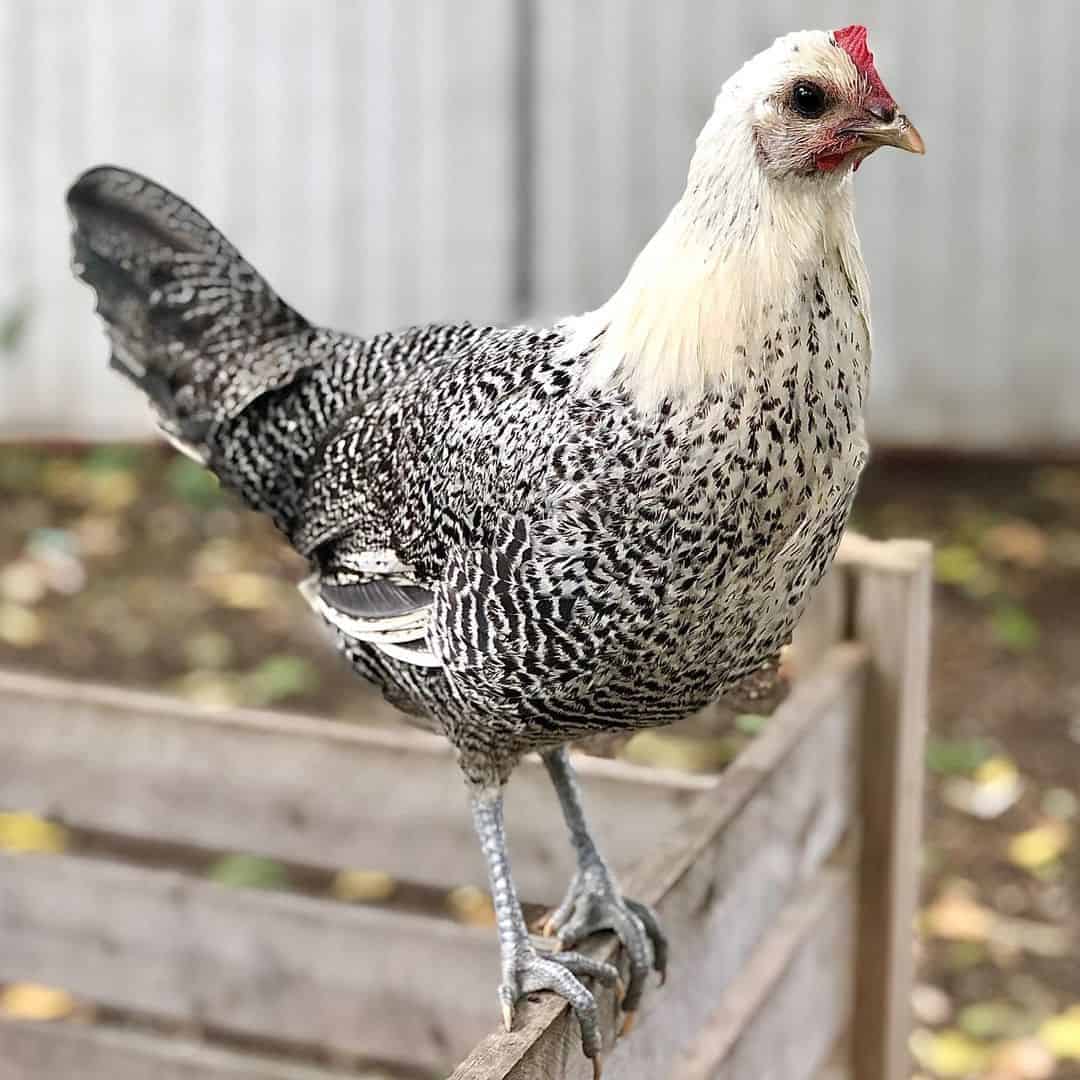
| Feature | Details |
| Purpose | Dual-purpose |
| Egg Color | White |
| Egg Size | Small to Medium |
| Broodiness | Broody |
| Heat Tolerance | Yes |
| Cold Tolerance | No |
| Comb Type | Single Comb |
| Egg Production | About 180 to 200 eggs per year |
| Chicken Skin Color | Yellow |
| Life Span | 5-8 years |
| Adult Weight | Hen: 3-4 lbs, Rooster: 4-5 lbs |
| Backyard Friendly | 4/5 |
Appearance
Most breeders like the Egyptian Fayoumi because it is beautiful and small-sized. It was first discovered in Fayoum, which lies west of the Nile and southwest of Cairo. Fayoumis have slender bodies, long necks, and tails tilted upwards.
Their carriage is a wonder to behold, and their black feathers have silver or white markings, while their legs are usually blue or green. Their bright and big eyes help them in surveying their surroundings for predators. This chicken breed has a single, large comb and matures quickly.
Personality
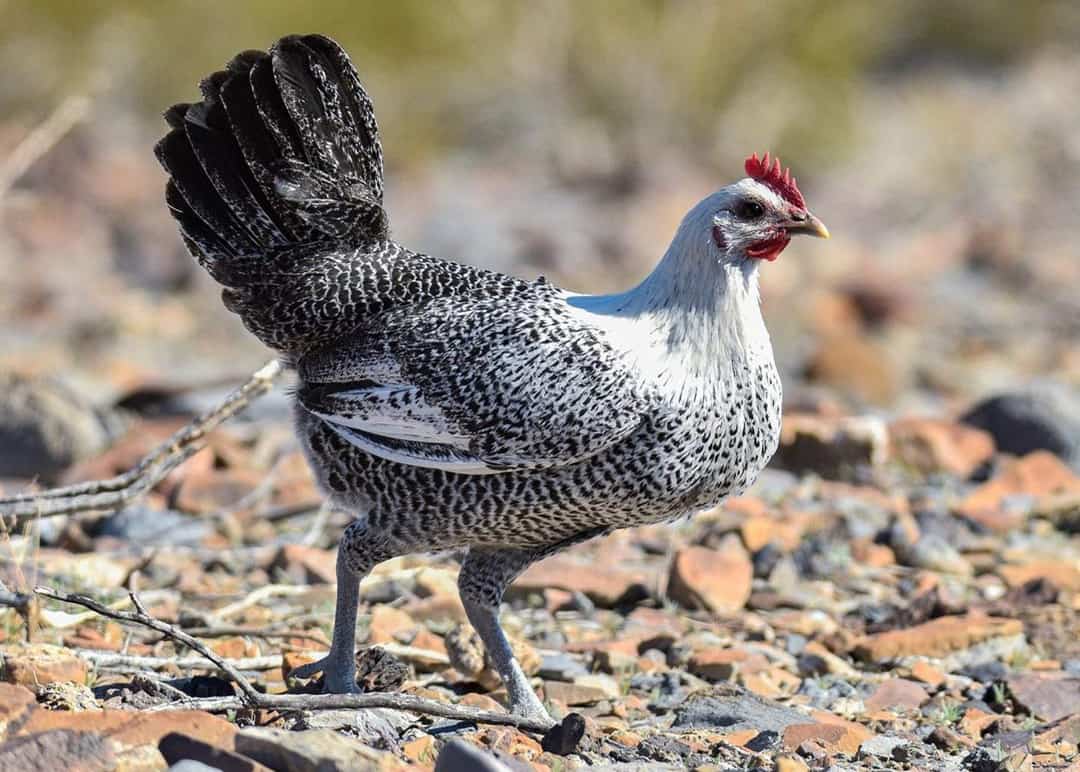
Even though they are small-sized, the Fayoumis are very alert and active. You’ll find them jumping at most points in time. Foraging is their second nature, so you must ensure the shelter is big enough to allow them to forage.
In addition, Fayoumis can be fierce. As such, you’ll find it challenging at some point when breeding them. You also won’t have much success with domesticating Fayoumis completely, but you can control them to some extent as long as you meet all their requirements.
If you’re looking for chickens to pick up and pet, Fayoumis aren’t the right chickens for that. They’d prefer to be left alone. Children have to be extremely careful around them.
Egg production
Fayoumis lay white/off-white eggs, which are delicious and pretty small but have high yolk content. You’ll likely get up to 200 eggs per year from each Fayoumi.
Care
One of the qualities breeders like about the Egyptian Fayoumis is their natural resistance to common poultry diseases like Avian Influenza. As such, they have become subjects of interest in the science community.
They are heat-tolerant but not cold-hardy. If you want to be successful at raising them, allow foraging as much as they want. Keeping them cooped up won’t augur well. In place of this, they can lay eggs anywhere, so you should always check out their foraging spaces for eggs. Learn more about Egyptian Fayoumi Chicken.
Common FAQ

Now that we are on the topic of chickens that lay white eggs, here are some common questions about it.
1. Which are better white or brown eggs?
The white vs. brown eggs debate comes down to what the individual prefers, as their flavor and nutrition content are practically equal. Thus, it would be incorrect to suggest one color has more health benefits than the other. Though people believe brown eggs contain more nutrients when compared to other colors, there is no scientific evidence to assert this theory is factual
2. Which brown chickens lay white eggs?
Often the breeds of brown chickens, such as Plymouth Rock (Barred Rock), Sussex strains, and Welsummer chickens, that usually lay brown eggs may produce white-shelled ones instead. However, this outcome is highly unusual and unpredictable given these circumstances are typically caused by a mutation. To be more consistent opt for lighter pigmentated breeds like buff or white.
3. Do red chickens lay white eggs?
Research from the Egg Nutrition Center has indicated that egg color is based on the breed of hen. Typically, red feather chickens such as Rhode Island Reds or New Hampshire Reds lay only brown eggs, while those with white feathers like Leghorns and Anconas tend to lay white eggs.
A variety of darker to lighter hues of brown is common in other breeds, though occasionally true white eggs can also be found among these red-feathered breeds. While there may be some correlations, the specific color of the chicken’s plumage does not definitively predict the color of the egg produced by the particular bird species.
Summary
The breed of the chicken determines the egg color. For instance, certain breeds lay white eggs, while others lay brown eggs. If you love white eggs, you have to go for chicken breeds that lay white eggs. However, both white and brown eggs have the same amount of nutrients.
With this list of seven chicken breeds that lay white eggs, your search can be much easier.

Joseph Hudson has been raising chickens for over 15 years. In 2018, he completed the Agriculture & Natural Resources program at Mt. San Antonio College. He currently raises over 1400 chickens on his 7.5-hectare farm. He keeps sharing his experience on raising healthy and happy chickens on Chicken Scratch The Foundry.
